Ethereum has faced scalability issues due to increased transaction volume, leading to rising fees and transaction processing delays.
Many Ethereum Layer 2 projects have not placed importance on maintaining a close connection with Ethereum, leading to issues such as fragmentation between L2s and sequencer centralization.
Taiko aims to be a true Ethereum Layer 2 by maintaining full interoperability with Ethereum, prioritizing the decentralization of sequencers, and providing full support to developers.
Taiko has made significant progress in addressing Ethereum's scalability issues through its mainnet launch and community engagement, while adhering to its core principles.
Ethereum first emerged in 2015, aiming to maximize the potential of blockchain technology through smart contracts and dApps. However, as the Ethereum network experienced an explosion in user numbers and transaction volumes, it encountered serious scalability issues.
Initially, the number of transactions on Ethereum was relatively low, so the blockchain's processing capability was not a significant concern. Users could process transactions quickly and inexpensively, and the network operated stably. However, as Ethereum's popularity soared and various dApps, such as DeFi, gaming, and NFT marketplaces, began to emerge, transaction numbers skyrocketed. Consequently, the time required to include transactions in a block increased, and transaction fees rose sharply. This was particularly burdensome for users engaged in small transactions or requiring rapid transaction processing.
To address these issues, the Ethereum Foundation and community explored various solutions. One of the most prominent solutions was sharding. Sharding is a scalability solution that divides the blockchain network into multiple smaller "shards," significantly increasing transaction throughput. Similar to how multiple computers can process tasks simultaneously, sharding allows the Ethereum network to process more transactions quickly and efficiently. Ethereum aimed to introduce this technology to significantly enhance the network's processing capacity.
Despite the promising benefits, concerns about centralization and the technical challenges leading to development delays caused Ethereum to shift from direct sharding to a Layer 2 approach.
As Ethereum fully embraced L2 solutions, several Ethereum L2 projects emerged. Taiko, which we will introduce in this article, is one of these Ethereum L2s, but it has been developing with a unique direction distinct from many other Ethereum L2s. Since Taiko aims to address the issues faced by existing Ethereum L2s comprehensively, before diving into Taiko, let's first explore the path Ethereum L2s have taken and the issues they have encountered.
Ethereum Layer 2 comprises blockchain infrastructures designed to enhance transaction processing speed and reduce fees while maintaining the security of the Ethereum mainnet, Layer 1. The most notable types of L2 are Plasma, Optimistic Rollup, and zk Rollup.
Ethereum L2 projects began to develop their own Ethereum L2 blockchains according to their philosophies, methods, and beliefs, all while pursuing the shared goal of solving Ethereum's scalability issues. As a result, users benefited from lower fees and faster transaction speeds. However, was it a matter of direction or speed? Amidst the proliferation of Ethereum L2 blockchains, Ethereum and its scalability issues were beginning to take a backseat.
Essentially, Ethereum L2s were created to solve Ethereum's scalability problem, but many of these projects started to focus more on promoting their own mainnets rather than addressing the core issue. Many Ethereum L2s began operating in a way that deliberately excluded their connection to Ethereum, offering only minimal value linkage through bridges or, in some cases, not supporting it at all. This led to the creation of independent blockchains that were, in effect, unrelated to Ethereum.
For example, Blast, which launched its mainnet on February 29, 2024, initially emphasized its direction and narrative as an Ethereum L2. However, at some point, it started referring to itself as a "full-stack chain," distancing itself from Ethereum. The change of Blast's official handle on X (formerly Twitter) from @Blast_L2 to @blast was no coincidence.
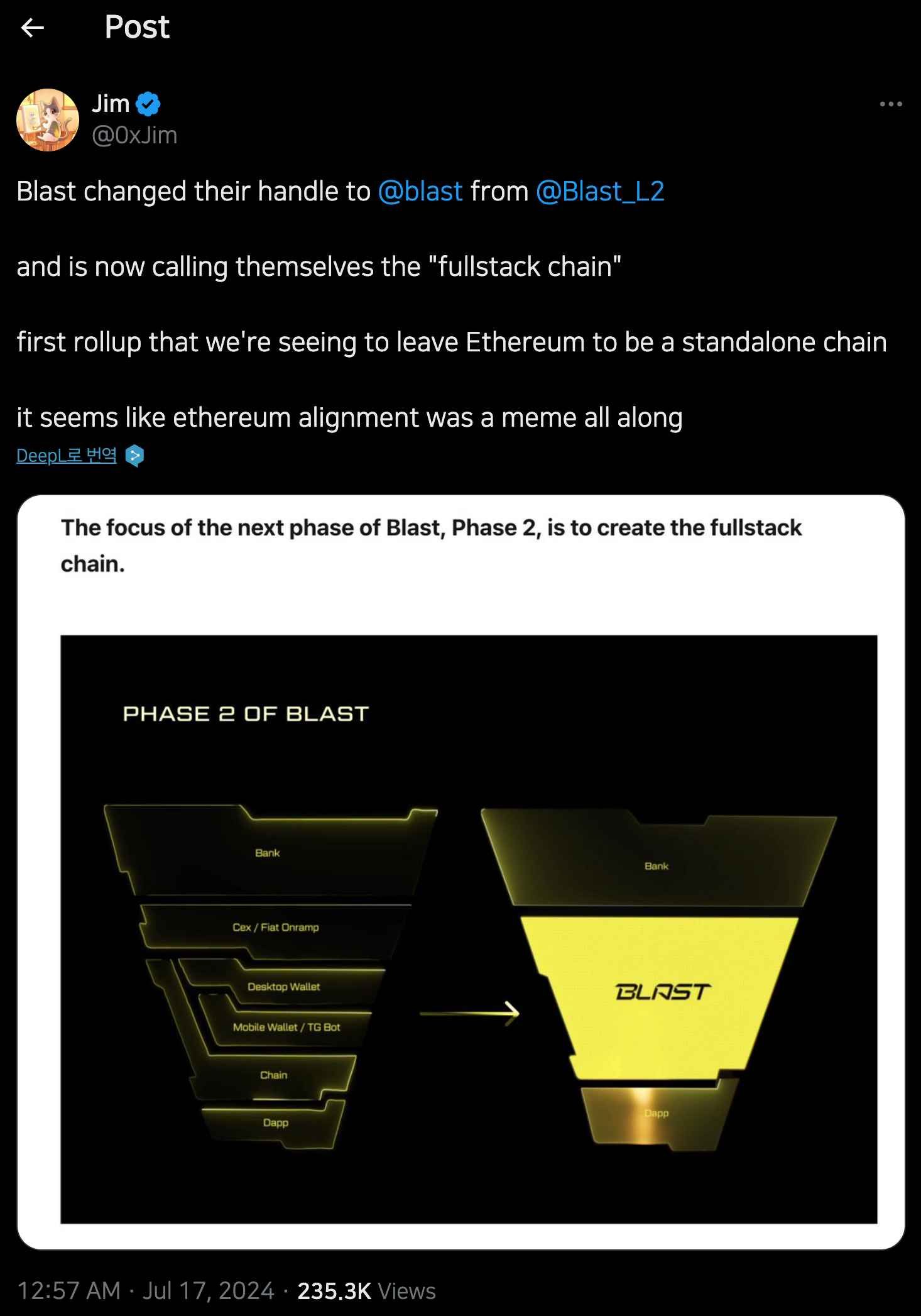
Source: Jim X
This indicates that while many Ethereum L2s claim to emphasize their connection to Ethereum and expand its scalability, there seem to be no true Ethereum L2s that genuinely uphold the narrative of working alongside Ethereum. So, what went wrong?
1.1.1 Decreasing Connectivity with Ethereum
Many L2 solutions are increasingly emphasizing their unique features and functionalities, leading to a gradual decline in connectivity with Ethereum. This desire to establish independent ecosystems stems from a desire for autonomy. However, this independence can hinder interoperability with the Ethereum mainnet, making it difficult for users to expect seamless interaction between L2 and Ethereum. As a result, the L2 blockchains, which were born to solve Ethereum's scalability issues, end up weakening the network's overall integrity. This goes against the original purpose of Ethereum's scalability solutions and could potentially cause confusion across the entire Ethereum ecosystem.
1.1.2 Centralization for Efficiency
Some L2 projects, in their pursuit of efficiency, have introduced centralized elements. While centralized approaches may offer higher performance and lower fees in the short term, they undermine the fundamental principle of decentralization that underpins blockchain technology. This can lead to a long-term sacrifice of trust and security in the technology. Additionally, a centralized structure creates a single point of failure, increasing security vulnerabilities, which poses significant risks to users and developers alike.
1.1.3 Ignoring the Needs of Builders
As L2 projects build their ecosystems, they have often imposed confusion and burdens on developers. Because each L2 project adopts a different technical approach, developers are forced to understand and adapt to multiple platforms. This creates a significant barrier to entry for developing new dApps or porting existing dApps to L2 blockchains. Moreover, without standardized protocols across L2 blockchains, developers face the hassle of modifying code to fit different infrastructures. This situation not only decreases developers' productivity but also hinders innovation and growth within the Ethereum ecosystem.
L2 projects may argue that they had no choice but to make these decisions to expand their ecosystems and secure capital. However, such trends ultimately weaken the security of the Ethereum mainnet, leading to negative impacts on the overall Ethereum ecosystem.

Source: Vitalik Buterin warpcast
In July 2024, Vitalik Buterin, the founder of Ethereum, published a post criticizing the current blockchain industry for its excessive investment in infrastructure. Vitalik pointed out that this overinvestment in infrastructure results from investors indirectly investing in technical aspects rather than directly in coins or tokens to satisfy their moral conscience. His observation seems to align with the unchecked emergence of L2 projects. As a significant amount of capital has flowed into infrastructure, projects focused solely on profit rather than the narrative of Ethereum scalability have emerged, pushing Ethereum and its scalability concerns out of the L2 narrative.
Of course, investment in the L2 ecosystem is not inherently bad. Capital is essential for running projects. However, this capital should never become the top priority. The most important thing is to focus on what the L2 solution is trying to solve and how it intends to do so.
L2 projects must not forget their original purpose of solving Ethereum's scalability issues. It is crucial to maintain interoperability with Ethereum, adhere to the principles of decentralization, and provide an environment where developers can easily participate. If L2 solutions fail to strike this balance, not only will the development of the Ethereum ecosystem be threatened, but the long-term trust and security of blockchain technology will also be at risk. When L2 projects return to their core principles and contribute to solving Ethereum's scalability issues through close collaboration with Ethereum, genuine progress in blockchain technology will be achieved.
So, what does it take to become a true Ethereum L2 that genuinely addresses Ethereum's scalability issues? Three key factors seem to be important here: 1) Is it fully integrated with Ethereum? 2) Is it fully decentralized? 3) Does it sufficiently consider the needs of builders operating within the Ethereum environment? Let's examine the efforts Taiko is making to become a true Ethereum L2 based on these factors.
The solution to Ethereum's scalability issues must naturally be well-integrated with Ethereum. Here, integration refers not only to system-level integration but also to value and, further, to philosophical integration. Of course, the term "integration" does not mean identical or duplicated in many aspects. Nevertheless, it is one of the virtues necessary to become a true Ethereum L2, as many blockchains continue to operate as Ethereum L2 without adhering to these basic principles.
2.1.1 Type-1 EVM Blockchain
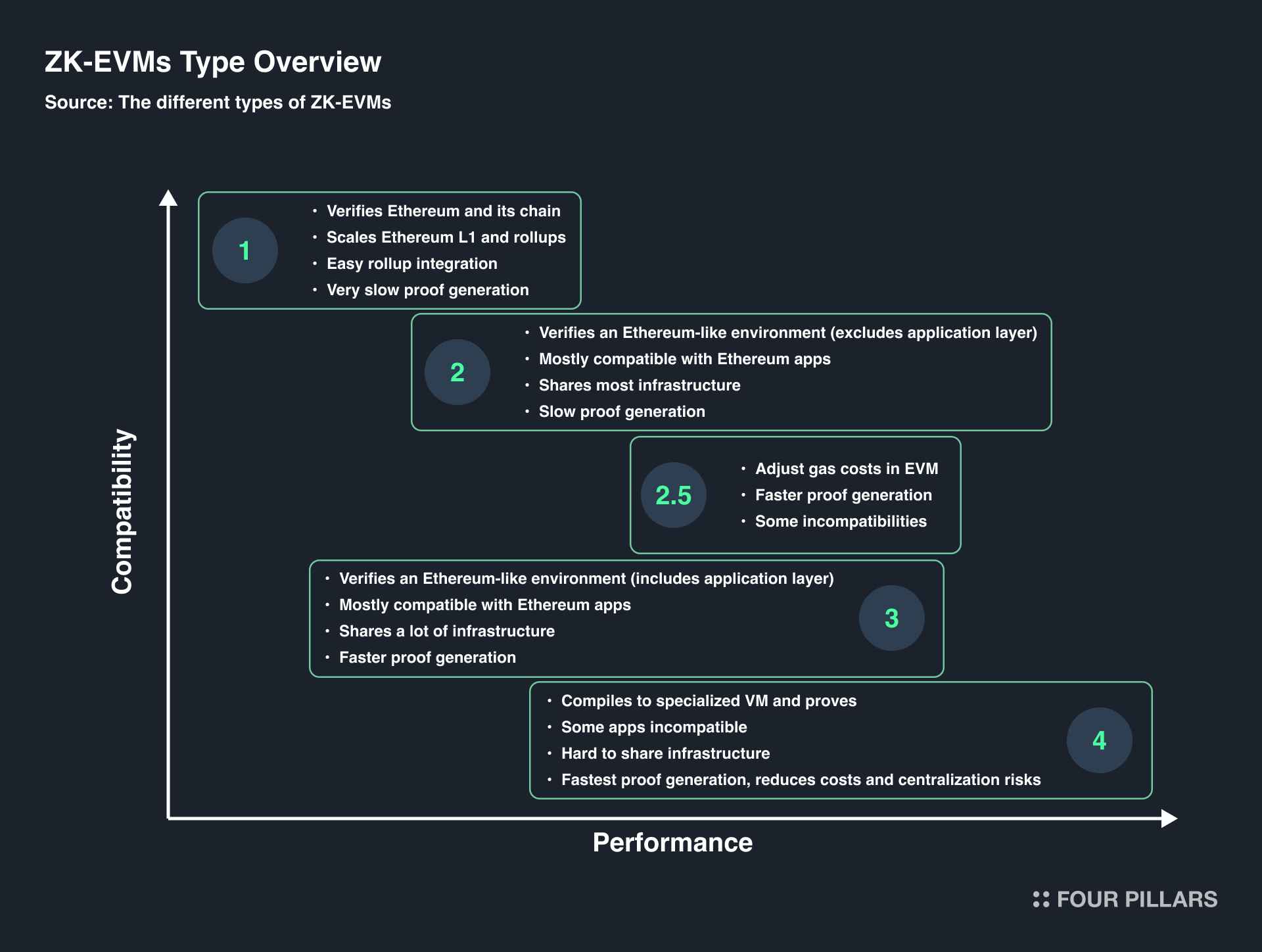
On August 4, 2022, Vitalik Buterin published “The different types of ZK-EVMs,” an analysis and classification of zkEVMs. According to his analysis, zkEVMs are divided into Types 1, 2, 2.5, 3, and 4, with higher numbers indicating decreased interoperability and compatibility with Ethereum, but increased efficiency in proof generation and overall performance. In other words, higher-numbered zkEVM types involve changes such as modifying the EVM core or introducing additional modules to optimize performance.
While Vitalik also noted in the article that none of the zkEVM types is technically superior and may potentially coexist, he concluded the piece with the following statement:
Personally, my hope is that everything becomes Type 1 over time, through a combination of improvements in ZK-EVMs and improvements to Ethereum itself to make it more ZK-SNARK-friendly.
Ultimately, in the choice between interoperability and performance, Vitalik sided with interoperability for Ethereum's scalability.
Although this article was written two years ago in 2024, it is worth reflecting on, especially now that a large number of Ethereum L2 blockchains have emerged. To truly function as a genuine Ethereum L2 blockchain, the ultimate goal should be to achieve a Type-1 zkEVM.
While Vitalik's article classified only zkEVMs, if we take a broader perspective, the structure of L2 itself can also be extended to the type of EVM or L2 depending on whether it is fully integrated with Ethereum. From this perspective, Taiko aims to provide Ethereum's scalability by using a Type-1 EVM that is Ethereum-equivalent.
As Taiko aims to be a Ethereum-equivalent L2 blockchain, it inevitably shows relatively lower performance compared to other types of Ethereum L2 blockchains, such as Type 2 or Type 3. However, considering that the other L2 blockchains mentioned earlier are not fully committed to Ethereum's scalability, this trade-off might be understandable. It is also worth noting that this is not a major concern, as the Taiko team is aware of this issue and has explicitly set their goal to improve the performance shortcomings through internal protocol design.
2.1.2 Based Rollup
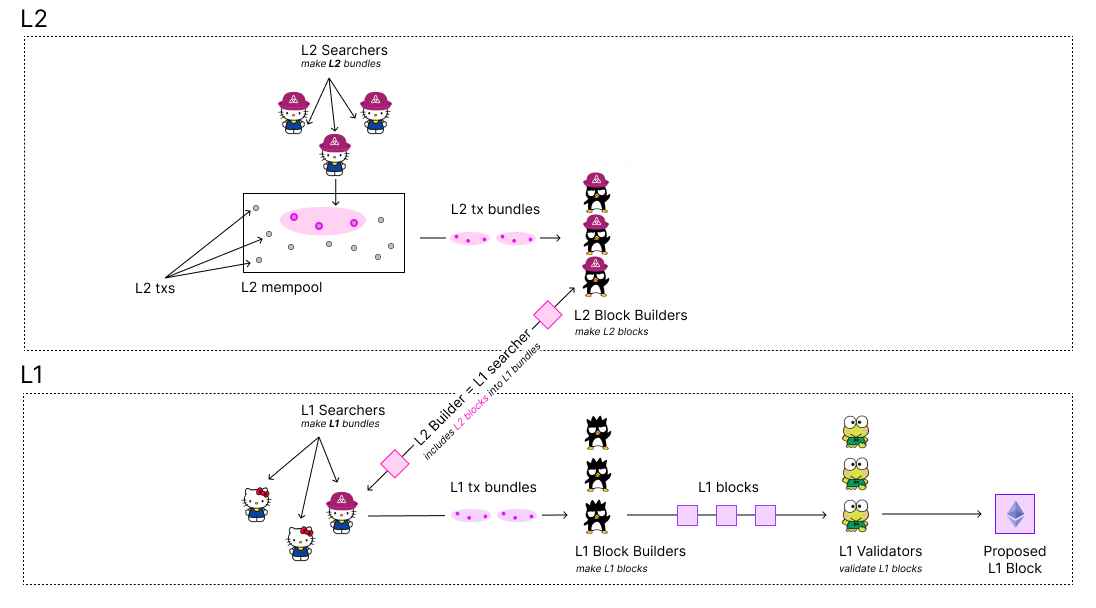
Source: MEV for “Based Rollup”
Taiko not only fully integrates with Ethereum's system infrastructure but also attempts to fully align with Ethereum's security aspects. Taiko utilizes a concept known as a Based Rollup, which operates without a centralized sequencer. Instead, Ethereum validators also take on the role of Taiko's sequencers, responsible for sequencing transactions and blocks. Due to these characteristics, there is a strong possibility that the fragmented Ethereum ecosystem could be reintegrated towards Ethereum as a whole.
Due to the Based Rollup’s features, Ethereum block proposers are the Taiko’s sequencers. This role comes with specific duties, including maintaining their profit as Taiko’s MEV (Maximal Extractable Value) beneficiaries and having liveness as sequencers. This sense of additional incentives encourages them to operate with extra care.
From a system perspective, decentralization is a cumbersome and inconvenient concept. Honestly, if everything were handled and managed from a single point, it would undoubtedly be more efficient and easier to maintain. Consequently, many Ethereum L2s have adopted centralized sequencer models. However, this approach has drawbacks, such as the potential for malicious sequencers to censor transactions or amplify the impact of a single point of failure. In such a scenario, who would trust the system? The blockchain industry was developed precisely because no one could be trusted. To eliminate these potential risks, complete decentralization is essential.

Source: Based Contestable Rollup (BCR): A configurable, multi-proof rollup design
What needs to be fulfilled for complete decentralization? Taiko pondered this question and introduced the Based Contestable Rollup (BCR). The key point to avoid centralization is ensuring the presence of multiple participants and preventing collusion while encouraging competition. BCR, adopted by Taiko, is a rollup characterized by a competitive mechanism among rollup proofs and sequencing based on that mechanism, encompassing all the essential elements.
34,469 lines of code are not going to be bug-free for a long time.
Vitalik Buterin
The reason Taiko chose the BCR structure is to create a completely decentralized environment. Vitalik Buterin's argument emphasizes that zk-SNARKs are not yet a fully reliable module. In particular, the latest zk-SNARK systems have become significantly more complex, greatly increasing the likelihood of bugs. And since it is still an unfinished technology, it is expected to become even more complex, making it vulnerable to technical errors. When such vulnerabilities exist, a centralized rollup may not allow a problem to escalate too much since there is an entity responsible for and capable of resolving any technical errors or specific risks. However, in the case of Taiko, which aims for a fully decentralized environment, it is difficult to clearly resolve such issues. Therefore, Taiko avoids a structure that blindly trusts zk-SNARKs. In other words, through the BCR structure, Taiko is prepared for the possibility of rollup proof errors and has established a system that allows challenges to incorrect rollup proofs.
To understand how Taiko's BCR works, a simple example might be more effective than a complex explanation.
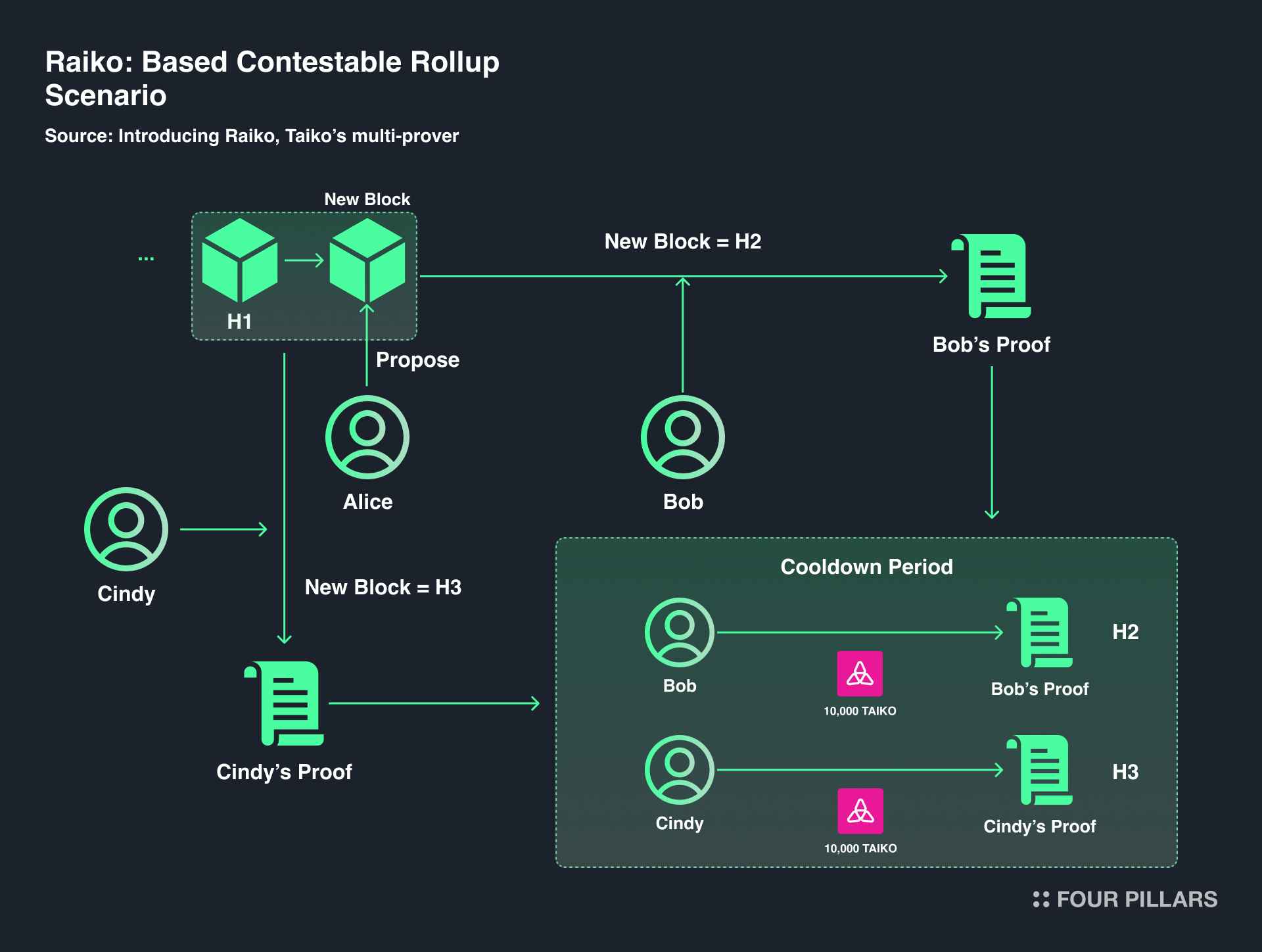
Alice proposes a new block.
Bob submits a proof of state change from H1 → H2. H1 is the parent hash, and H2 is the new block hash. Bob stakes 10,000 TAIKO as a deposit. His proof enters a cooldown period.
The state information proposed by Bob, along with the attached proof, is publicly disclosed.
Cindy determines that Bob's state change should be H1 → H3, not H1 → H2. Cindy stakes her 10,000 TAIKO during the cooldown period as a competing deposit and challenges Bob's proof.
The state change under contention between Bob and Cindy is held in cooldown, awaiting a higher-level proof. This higher-level proof allows Bob and all other provers the opportunity to challenge it.
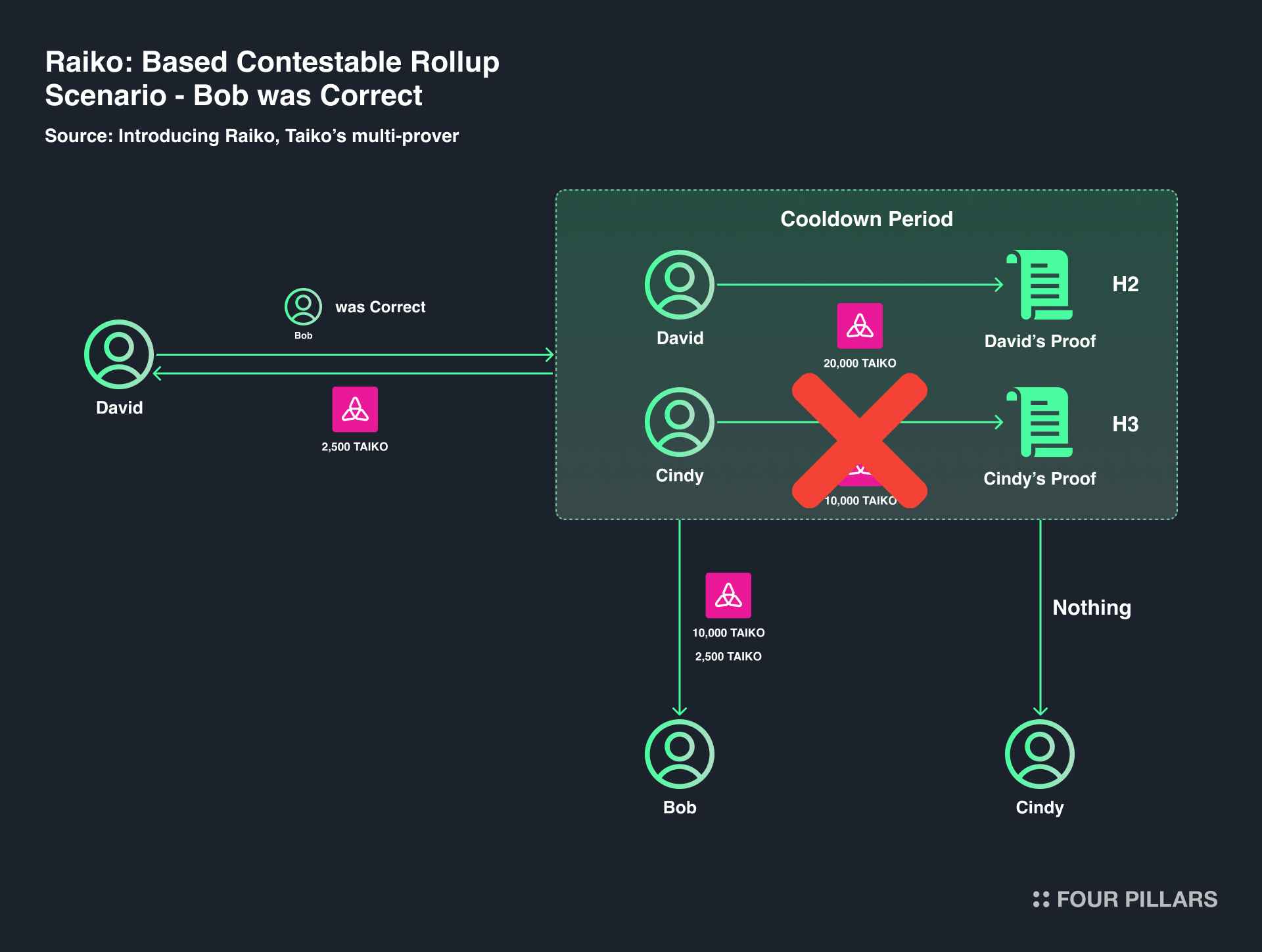
Scenario 1 - If Bob's proposal was correct:
David verifies Bob's H1 → H2 proposal, indicating that Bob was correct. David receives 2,500 TAIKO as a reward for performing the higher-level proof and becomes the prover for H1 → H2, staking 20,000 TAIKO as a deposit.
Cindy loses her entire deposit since she made an incorrect modification proposal.
Bob receives his original 10,000 TAIKO deposit back, plus an additional 2,500 TAIKO as a reward for making a correct proposal.
The cooldown period for David's new proposal and proof begins.
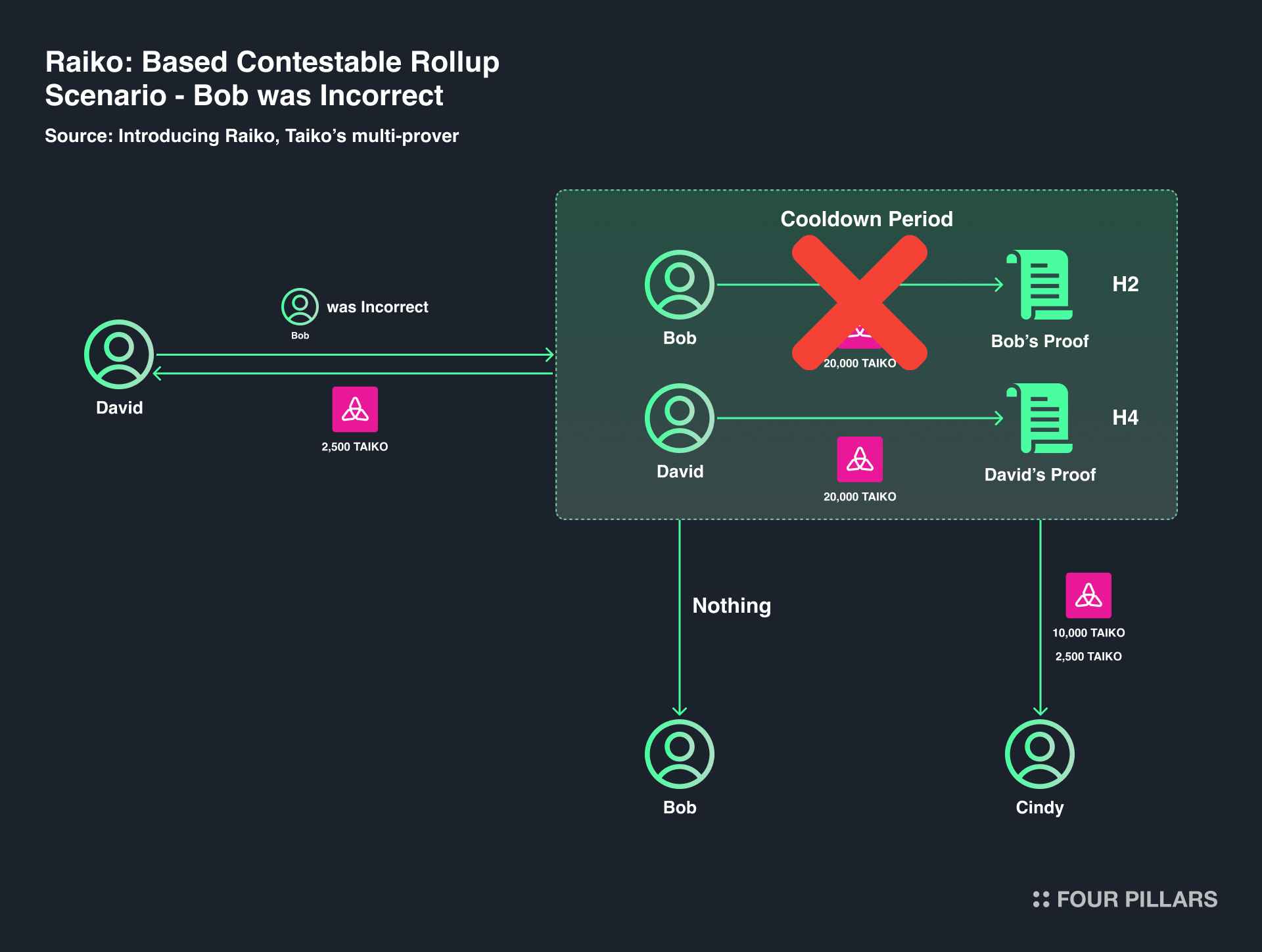
Scenario 2 - If Bob's proposal was incorrect and David made a new proposal:
David provides a three-step proof of transition from H1 → H4, indicating that Bob's transition was incorrect. David receives 2,500 TAIKO as a reward and stakes 20,000 TAIKO as a deposit, leaving a capital basis for his modified state information and proof.
Cindy receives her original 10,000 TAIKO deposit back, plus an additional 2,500 TAIKO as a reward for making a legitimate challenge against Bob's incorrect state change information.
Bob forfeits his entire deposit due to the risk of proposing incorrect state change information and proof.
The cooldown period for David's new proposal and proof begins.
This structure, using competitive deposits, incentivizes rollup provers to be responsible when challenging and prevents unnecessary attacks. Notably, as the verification rounds continue, the deposit required for competition significantly increases, preventing unnecessary competition rounds.
Moreover, Taiko has adopted a multi-proof system within the BCR. This system allows the use of different rollup proof systems (SGX, ZK, SGX+ZK, etc.) depending on the stage, ensuring system flexibility and more stable operations. Despite these advantages, this design has a drawback: the lack of prover activity when competition frequency is low. The structure for prover requires a large amount of competition to generate profits, so in environments where this is not the case, it may be a better choice for them not to participate. To prevent this issue, Taiko has implemented a dynamic adjustment to different rollup proof systems, allowing the problem to be addressed.
This issue of low competition frequency may arise during the service's early stages. To address this, a group of provers known as Guardian Provers, using a multi-signature scheme, will act as a safety net until the system matures. As the system matures, their role will gradually diminish, eventually disappearing to achieve complete decentralization.
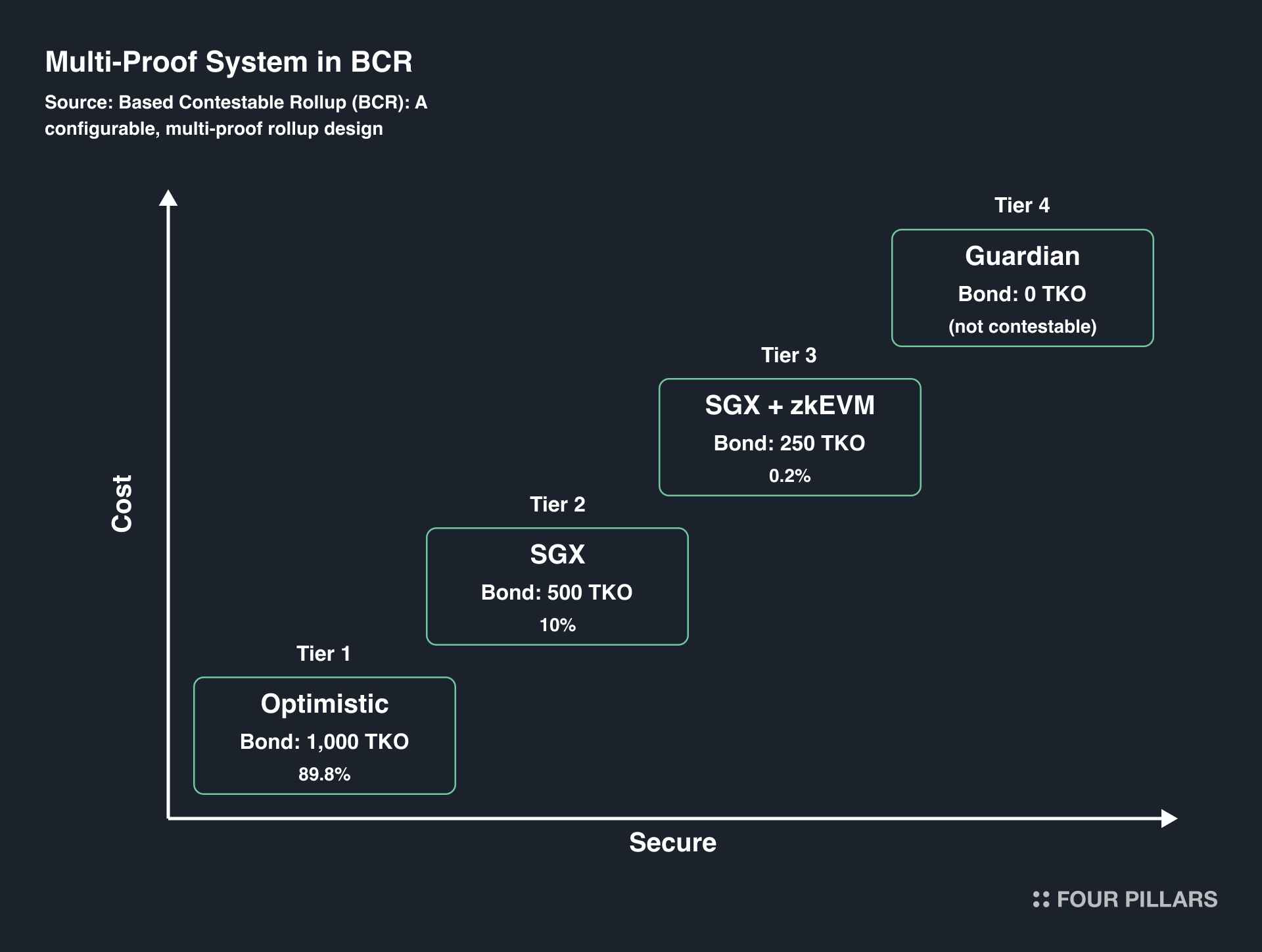
The various features claimed by Ethereum L2s and the more decentralized L2s are all attractive and necessary. However, we miss the most critical question: Why do Ethereum L2s exist? Or who are they meant to benefit? The answer is simple. They exist for the participants of the ecosystem who want to use these Ethereum L2s. Among them, the builders who attract many users and drive the entire L2 ecosystem are the most important. Yet, in this golden age of Ethereum L2 blockchains, there is an overwhelming abundance of infrastructure created with individual rules. Simply put, it's like trying to operate the same service in multiple countries, each with vastly different laws and regulations, requiring unnecessary time and money to resolve.
So, how can we help builders efficiently focus their resources on developing services? The answer is to standardize rules and narrow the gaps between infrastructures. To make this a reality, it is essential to bring in infrastructure that has been historically refined or is already widely used by many builders. That's right: we need to bring in the infrastructure used in the Ethereum environment. This allows builders to use the methodologies and know-how they have already developed on Ethereum, enabling them to settle comfortably into the Ethereum L2 blockchain.
Taiko will only make a difference in this world if it helps others make a difference in this world.
In this regard, Taiko is showing genuine dedication to builders. The Taiko blog post mentioned above highlights that Taiko will benefit from allowing ecosystem participants, especially builders, to work freely. To honor this statement, Taiko continues to release all development implementations as open source and has adopted a structure called Based Booster Rollup (BBR) to help EVM builders transition faster and more easily.
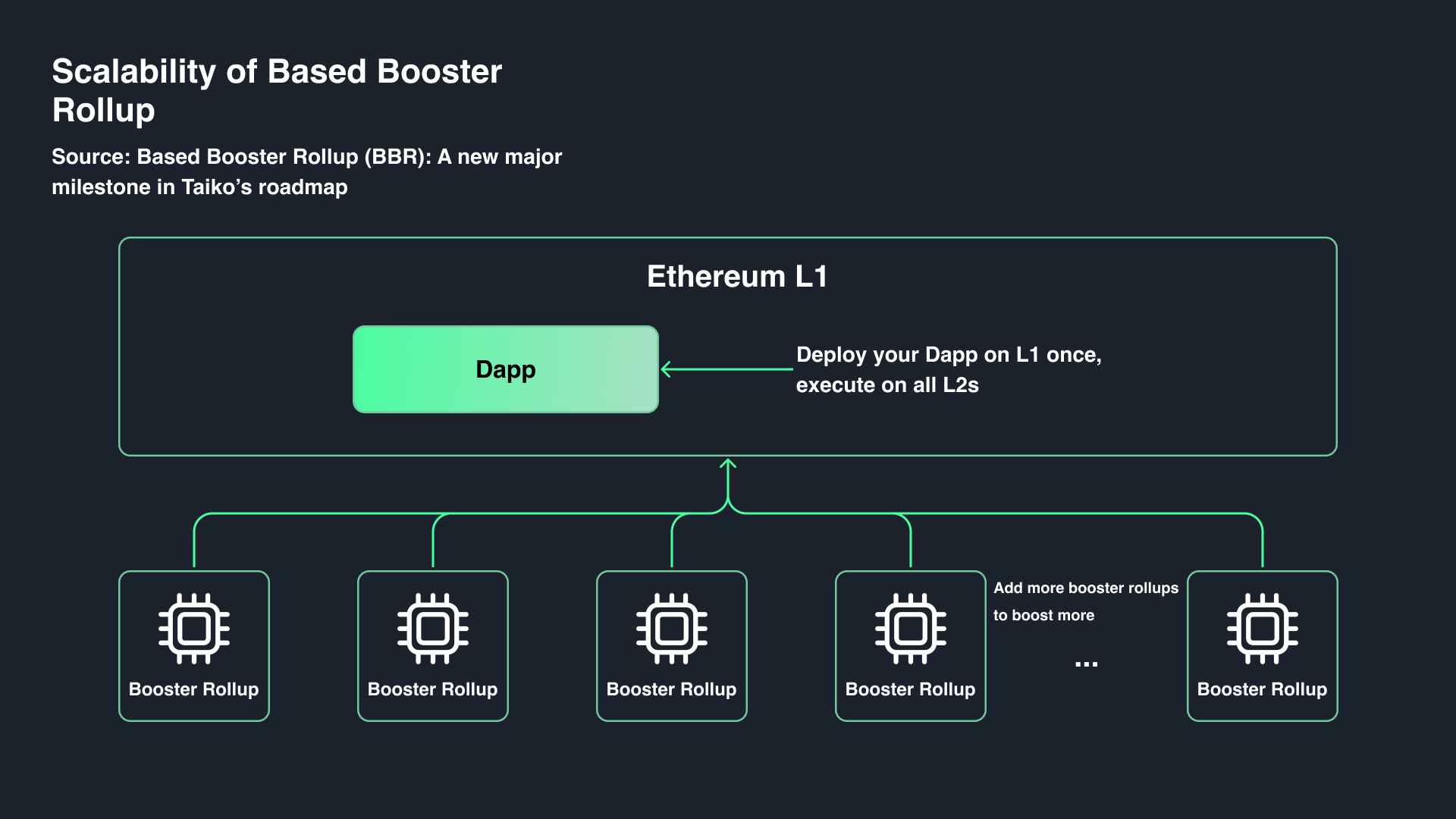
BBR is an extension of the Based Rollup's benefits from a builder's perspective, answering the question of what if we could apply the advantages of Based Rollup to the application side of blockchain core infrastructure. With Taiko's BBR, builders can deploy their dApps on L1 Ethereum once and experience automatic dApp deployment across all L2s without the need for additional work or resource expenditure.
BBR operates similarly to adding extra CPUs or SSDs to a laptop. By adding additional module components to the existing computer, enhancing performance without altering the basic structure, BBR enables apps and services to grow faster and more significantly within the existing structure of L1 Ethereum.
Through this, Ethereum validators can propose blocks for the entire BBR network, and combined with the advantages of fully integrated L2, BBR can be used as a solution to instantly scale Ethereum. Ultimately, this approach can solve the fragmentation problem faced by all current rollups. In other words, while maintaining the sequencing and all associated benefits of L1, cross-rollups through networking between all L2s associated with L1 become possible, achieving the scalability that Ethereum has long sought.
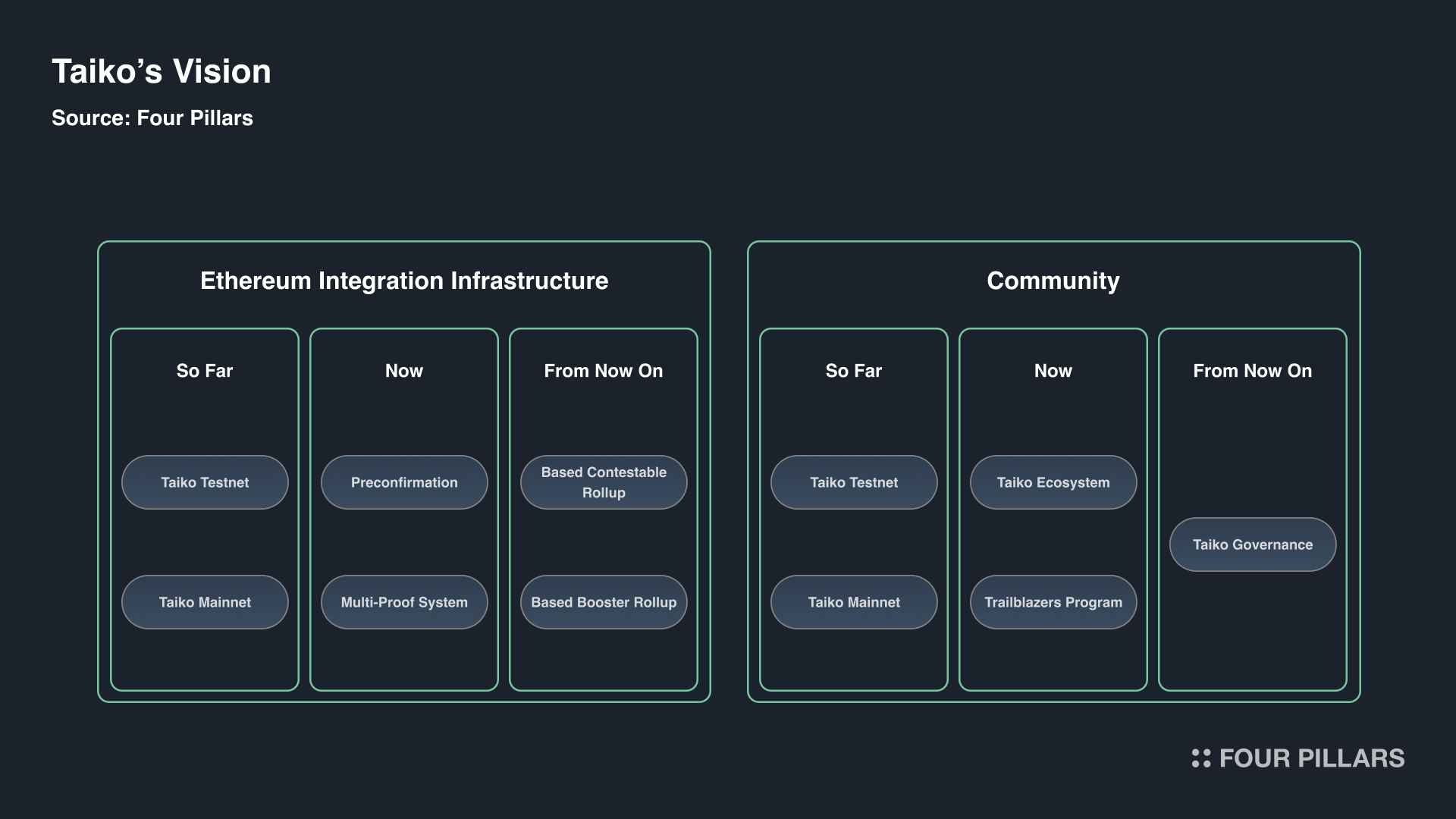
We have explored the direction Taiko is aiming for. Despite having three strong narratives as its foundation, ideas alone cannot make an industry game-changer. The ideas must be implemented within the planned timeframe, enabling others to benefit from these implementations, creating a virtuous cycle, and becoming a game-changer. So, let's examine the process by which Taiko intends to become a game-changer from past, present, and future perspectives.
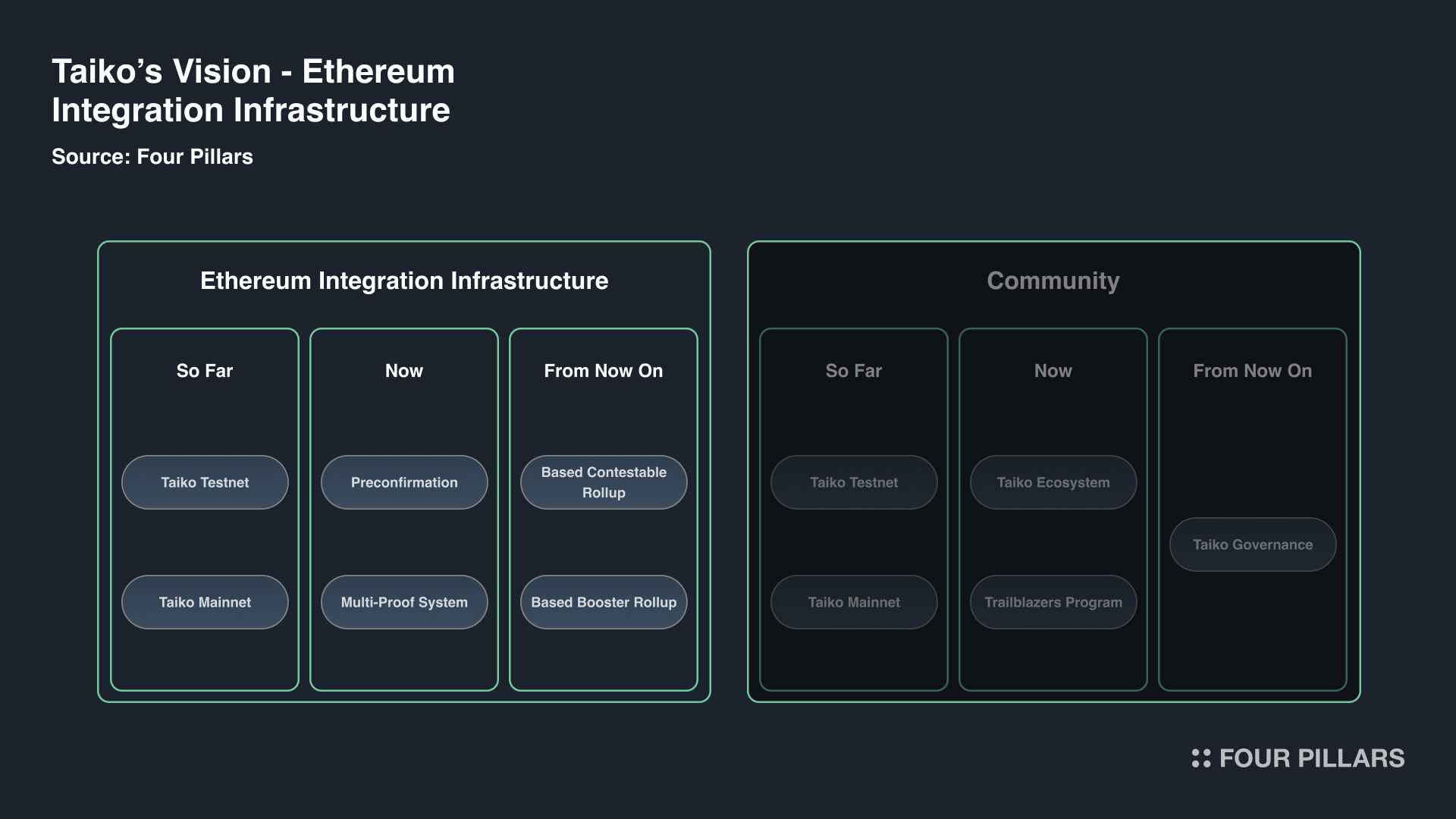
One of the two critical pillars is infrastructure. As the cornerstone for becoming a true Ethereum L2, Taiko is leveraging various technological strengths to build this infrastructure. Let's take a look at how Taiko's infrastructure history has unfolded.
3.1.1 So Far - From Taiko Testnet to Mainnet
Taiko didn't try to achieve everything all at once. To reach the significant goal of launching its mainnet, it conducted no fewer than seven alpha testnets, gradually preparing the implementation of the concepts Taiko envisioned. Let's first explore the content of the seven stages of the alpha testnet.
Alpha Testnet-1 (Snæfellsjökull)
All developers could deploy smart contracts, and users could use all Ethereum and Solidity tools as they do on Ethereum. This enabled everyone to test it out and generate some transactions. This version allowed anyone interested to run an L2 node, and it was open to participation as a proposer. To this end, Taiko planned to run some nodes and propose blocks, inviting everyone to join in. The testnet included a bridge for moving assets between the testnet and Ethereum, as well as a block explorer for checking transaction history.
Alpha Testnet-2 (Askja)
This was the first testnet to successfully verify that the network could operate through a proof mechanism open to all. It established the foundation for complete decentralization in this version. Additionally, monitoring and alerting of the blockchain network were implemented, and builders could deploy their dApps directly to this testnet without modifying their code used on Ethereum.
Alpha Testnet-3 (Grímsvötn)
This version established and implemented the foundation of tokenomics based on a new fee and reward model. It also included testing the essential proof cooldown process in the proof mechanism and initial testing of the inception layer for Taiko L3.
Alpha Testnet-4 (Eldfell L3)
This version first deployed the inception layer for L3, introduced with the concept of rollup-on-rollup. Since Taiko L2 is fully integrated with Ethereum, Taiko effectively treated L2 as L1 and attempted to expand to L3. Additionally, a new staking-based proof mechanism was introduced to prevent centralization of provers and ensure they receive reasonable rewards.
Alpha Testnet-5 (Jólnir)
This version included a new proposal and proof implementation based on Proposer-Builder Separation (PBS). PBS is a series of processes involving economic mechanisms between proposers and provers to ensure decentralization in block building. Unlike previous testnets, which did not introduce this aspect, block building now adopts an open market form following this version.
Alpha Testnet-6 (Katla)
The sixth testnet, Katla, implemented the initial version of BCR. Since Taiko aims to be a Ethereum-equivalent L2, this version prepared for and tested the integration of Ethereum's latest updates, such as EIP-4844, even though they were not yet activated. Additionally, the bridge was updated, and the block explorer was enhanced to provide more comprehensive information.
Alpha Testnet-7 (Hekla)
The final testnet, Hekla, focused on activating the EIP-4844, which had been prepared in the previous testnet. This successfully implemented and enabled the use of Blob, the new rollup storage mechanism on the Ethereum mainnet. Additionally, several improvements were introduced in this version of the testnet, including adjustments to L2 block gas issuance, activation of snap sync, and modifications to EIP-1559 settings. Based on the features applied and tested up to this version of the testnet, the mainnet is now ready to be prepared without any issues.
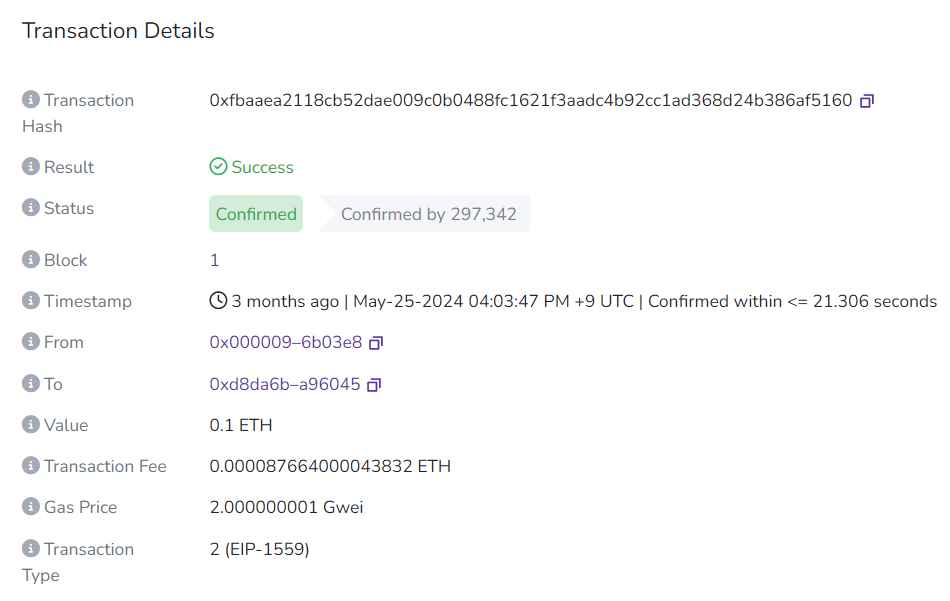
Source: Taiko Mainnet #1 Block
Taiko Mainnet
The content of the blockchain networks verified and secured during the testnets was unveiled to the world through the mainnet launch. Notably, Vitalik Buterin, the founder of Ethereum, generated the next block immediately following the genesis block, further adding significance. General users can transfer ETH from Ethereum to the Taiko mainnet via the bridge and interact directly with dApps on the Taiko blockchain. Builders, in particular, can run nodes, propose and prove blocks, and actively participate in the Taiko blockchain, a platform with immense potential. Technologically, Taiko introduced implementation modules representing its vision, such as BCR and Raiko, demonstrating its commitment to becoming a true Ethereum L2.
3.1.2 Now - Preconfirmation and Multi-Proof System
While Taiko progressed through six testnets to reach the mainnet, it was also solidifying its internal structure to become a more advanced Ethereum L2. Two of the most notable developments are the Preconfirmation and Multi-Proof systems, which we will explore further.
Preconfirmation
Even after launching the mainnet, Taiko continues to evolve in a direction that inherits Ethereum's security and finality. However, this evolution introduces a risk where block proposers may face a survival problem due to a lack of profitability. For example, in an ecosystem like Taiko's, where liquidity is scarce, users typically offer much lower tips to block proposers, making Taiko's 12-second block time insufficient for any block proposer to profit. As a result, Taiko Labs temporarily operates proposers without seeking profit to prevent such a situation from arising. If no action is taken, the block time on the Taiko mainnet will continue to increase.
To address the issues of L2 block building profitability, block time improvement, and data posting efficiency, Taiko plans to introduce a concept called Preconfirmation. Preconfirmation is a major focus of research and development in the second half of 2024 and will play an essential role outside the Taiko mainnet. Through Preconfirmation, L2 block building can become more efficient and stable, allowing users to experience faster transaction confirmations.
Moreover, Preconfirmation could simplify and strengthen the rollup structure by integrating the roles of L2 and L1 proposers. This connects with Based sequencing, which, when considering builder profitability, bootstrapping for survival, and configuring fast block times, may not operate smoothly in practice. However, if multiple Preconfers perform Preconfirmation, forks on the Taiko mainnet could occur. Therefore, despite some controversy, a mechanism like leader selection is being discussed as a practical compromise.
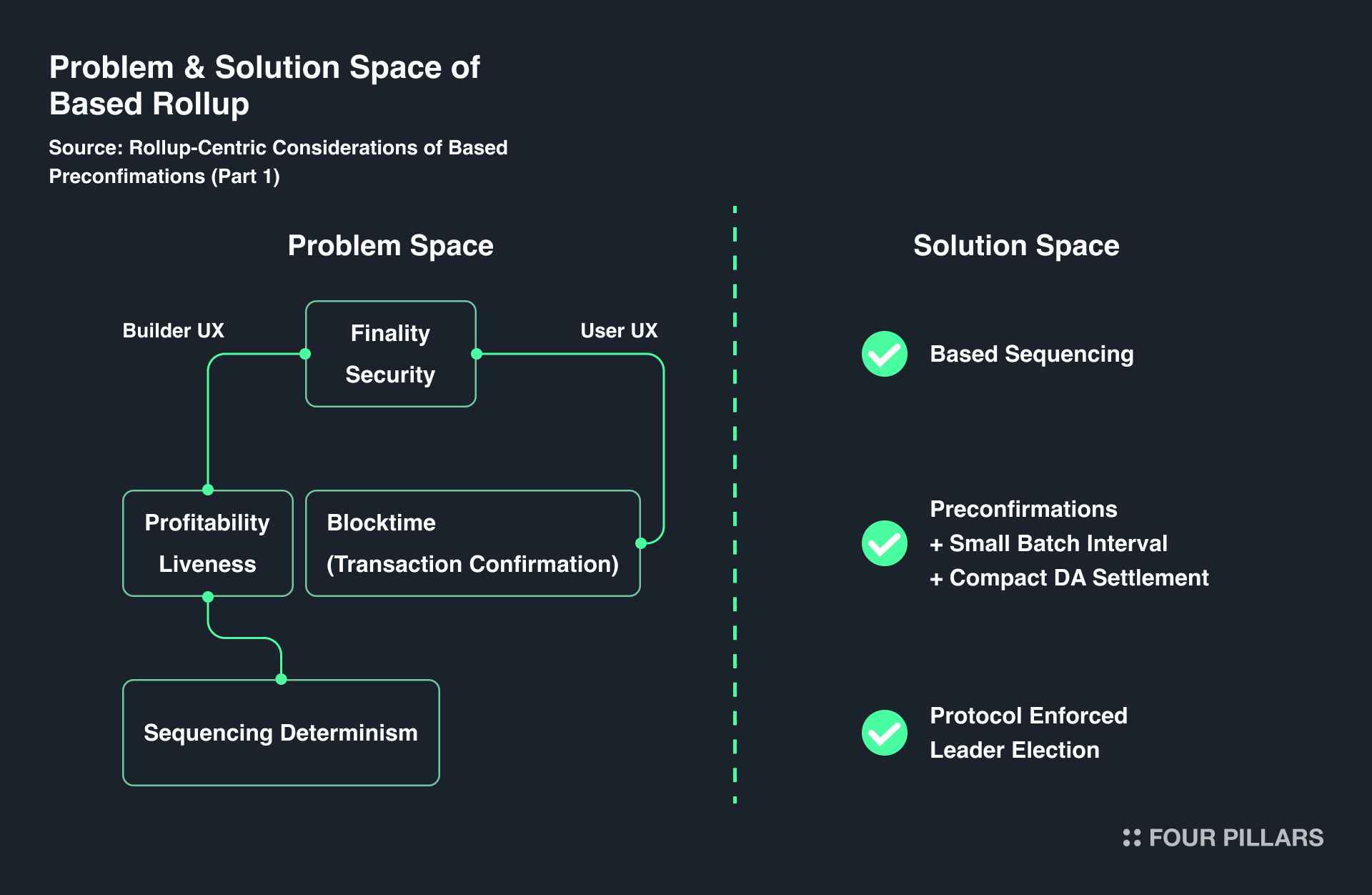
Multi-Proof System
Another research and development subject for Taiko is the Multi-Proof system, which aims to integrate multiple clients and various proof systems. The Multi-Proof approach reduces vulnerabilities due to client implementation and proof system bugs, ensuring that even if one proof method is compromised, others will prevent the same vulnerability from being exploited.
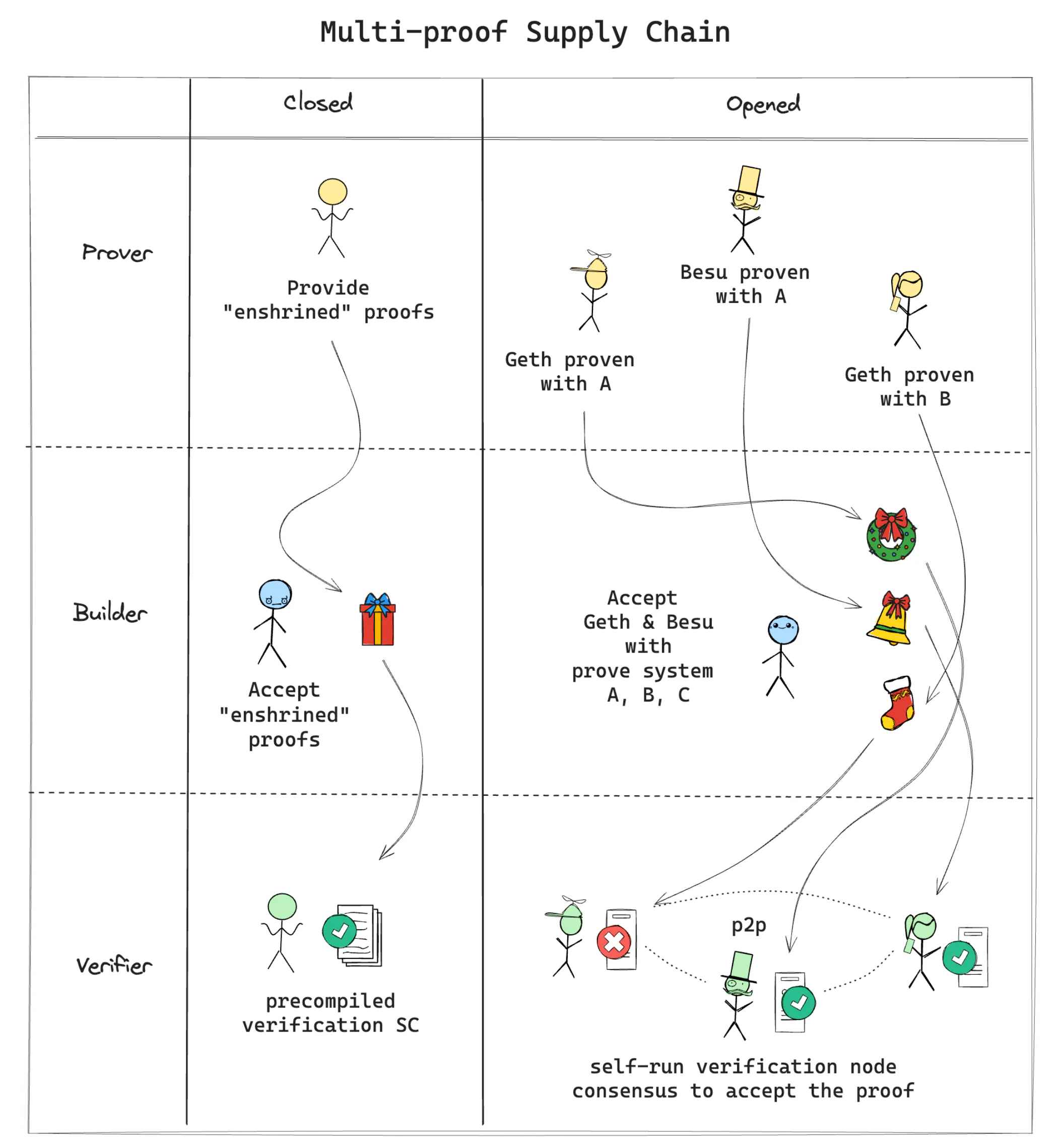
Source: Taiko’s Approach to Multi-Proofs
First, Taiko aims to establish an "Open" Multi-Client system where each client can independently validate blocks. This allows users to choose their preferred client for block validation, offering advantages in terms of accessibility and scalability. Additionally, it serves as a fundamental countermeasure against single points of failure, contributing to the safer operation of the mainnet. However, since this requires systemic support for Multi-Client functionality from Ethereum, which is the L1 network, Taiko plans to use a "Closed" system that employs various improved types of validators until such support is fully implemented.
Additionally, Taiko operates a free-market Multi-Proof system where proposers seek out provers, propose blocks, and proceed with verification using their chosen proof system. Furthermore, this Multi-Proof system emphasizes modularity and openness, allowing multiple clients and proof systems to collaborate in generating multiple proofs. To this end, Taiko collaborates with Powdr Labs, Risc Zero, and others to enhance interoperability between compilers and zk-SNARK systems and build a modular ZK stack.
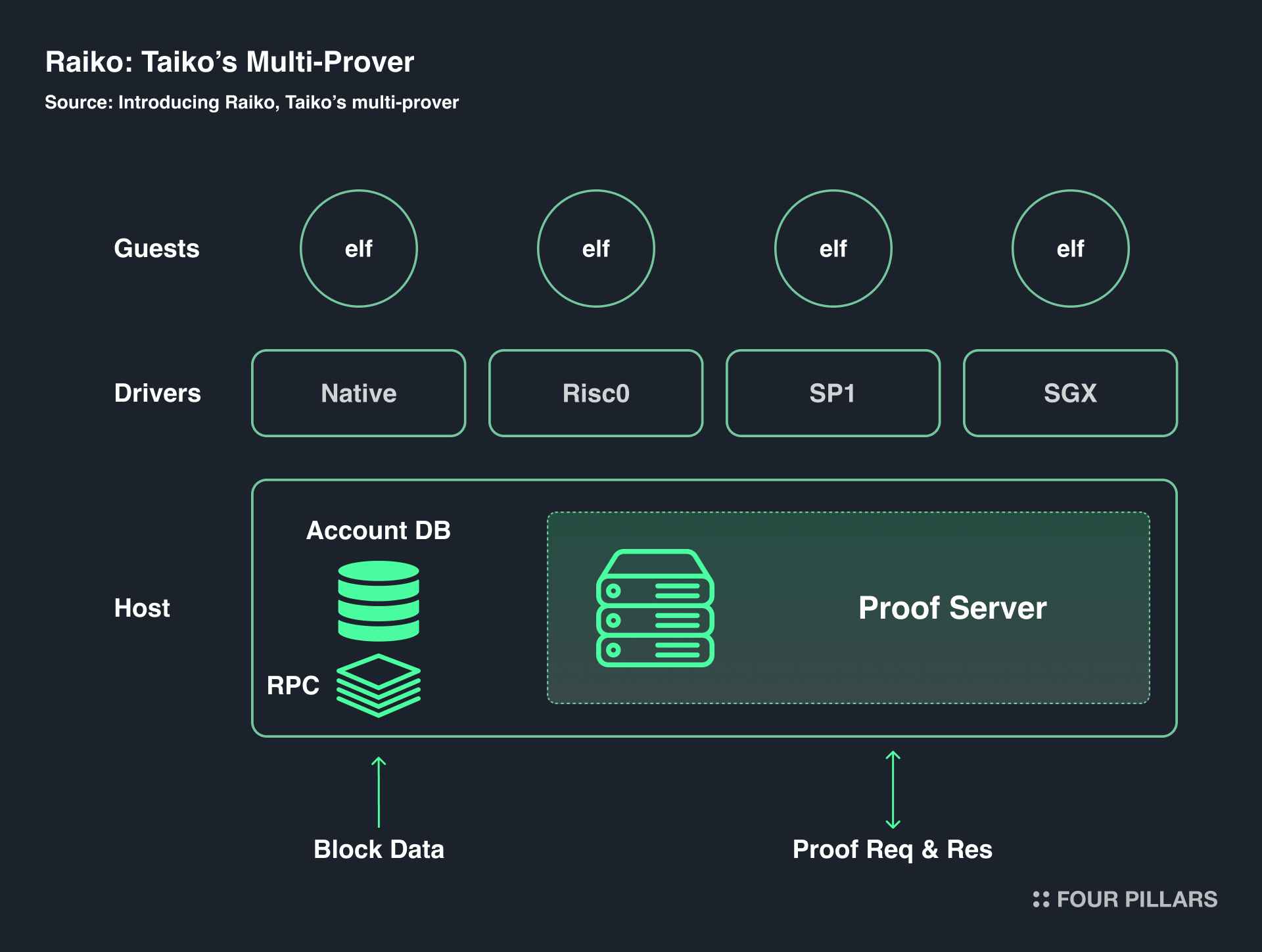
The implementation of these concepts is called “Raiko.” Raiko supports various zkVMs and leverages SGX to enhance security. This system increases the flexibility of block proofing through the ZK/TEE architecture and improves zkVM and TEE with standardized input methods. Taiko plans to continue integrating more zkVMs and expanding the Wasm zkVM. This system aims to provide a user-friendly and integrated environment for EVM-compatible block proofs.
3.1.3 From Now On - The Future with BCR and BBR
While Taiko has made significant progress, the goal of becoming a game-changer still seems distant. Ultimately, Taiko's path to its final vision relies heavily on two core elements, BCR and BBR, which have been initially implemented but still require further refinement.
Although we have already explained BCR and BBR above, let's revisit them.
BCR enables users and developers to propose blocks, run nodes, and deploy smart contracts in the same manner as on Ethereum, introducing a dispute resolution mechanism that allows errors within rollups to be swiftly addressed. This ensures finality and accuracy within the blockchain, making BCR a cornerstone of Taiko's core technology.
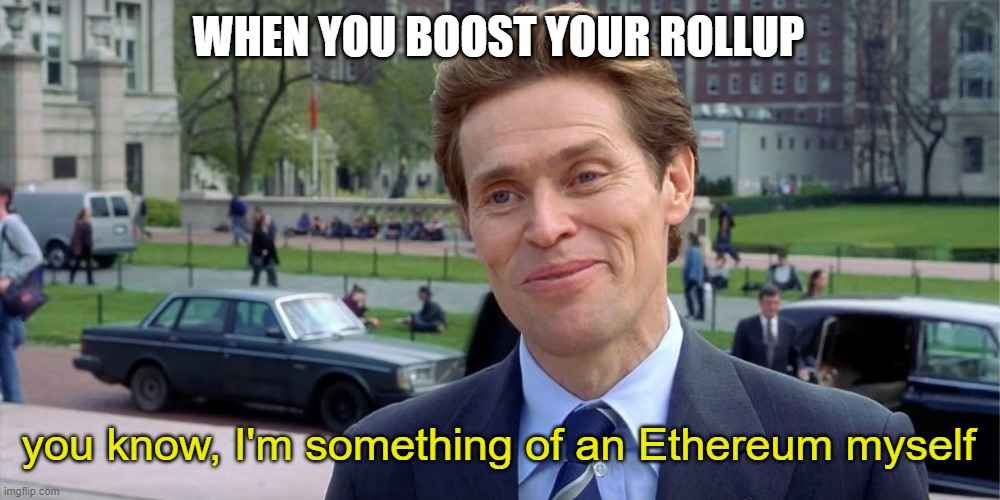
Source: Based Booster Rollup (BBR): A new major milestone in Taiko’s roadmap
BBR builds upon the advantages of Based Rollup, offering greater efficiency and full Ethereum interoperability. This allows users to use integrated dApps across all L2s without the need to move between them, while developers can deploy dApps once and have them automatically scale across all L2s. Furthermore, BBR addresses the fragmentation issue present in all rollups while significantly reducing transaction costs and increasing throughput. As a result, Taiko views BBR as having the potential to fundamentally scale the Ethereum ecosystem, and once this technology is implemented, all Ethereum network users and developers can expect an enhanced experience.
Taiko's mainnet aims to support developers, users, and builders, enabling them to work freely and efficiently within the Ethereum environment, focusing on these two core pillars. However, since these pillars are not yet perfect, they will need to continue evolving and improving to become essential technological components that help realize Taiko's vision. As these two pillars become stronger and more complete, Taiko will be able to present a new standard for L2s that offers full Ethereum interoperability, complete decentralization, and closer proximity to users and builders.
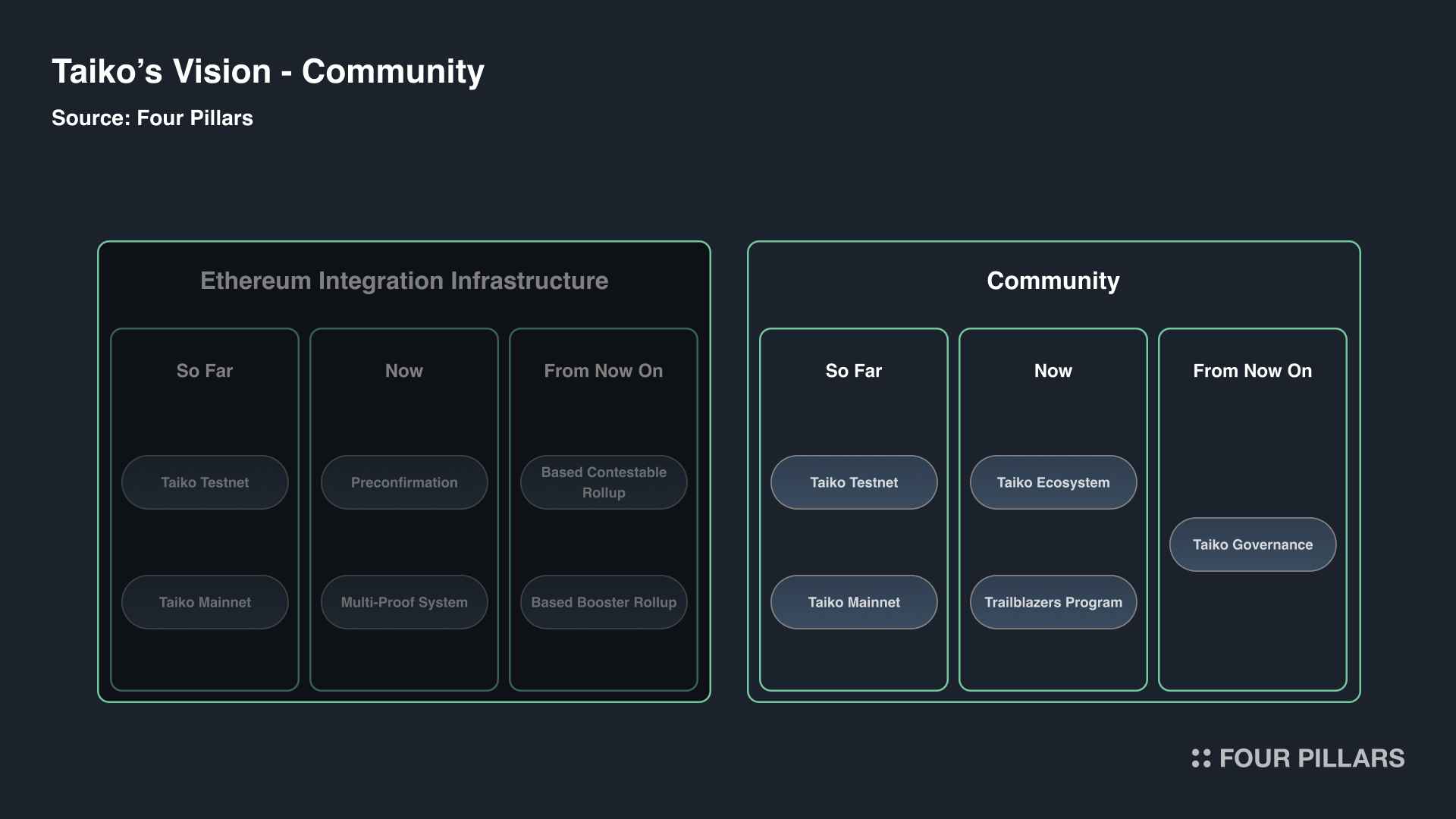
The other crucial pillar is the community. To ensure that the space Taiko establishes through its infrastructure truly becomes valuable, community engagement is essential. To this end, Taiko is making efforts in various areas, including token issuance, tokenomics development, ecosystem activation, and governance environment establishment. Let's explore some of Taiko's efforts in these areas.
3.2.1 So Far - TAIKO Token Issuance and Allocation
After the launch of the Taiko mainnet, an airdrop of TAIKO, the native token of the Taiko network, was conducted. TAIKO, which lies at the heart of Taiko's economic mechanisms and tokenomics, had an initial issuance of 1 billion tokens. The token generation event (TGE) for TAIKO occurred on June 5, 2024. The distribution is as follows: 11.62% of the total supply was allocated to investors, and 9.81695% to the Taiko Labs Core team, as illustrated in the accompanying graph.
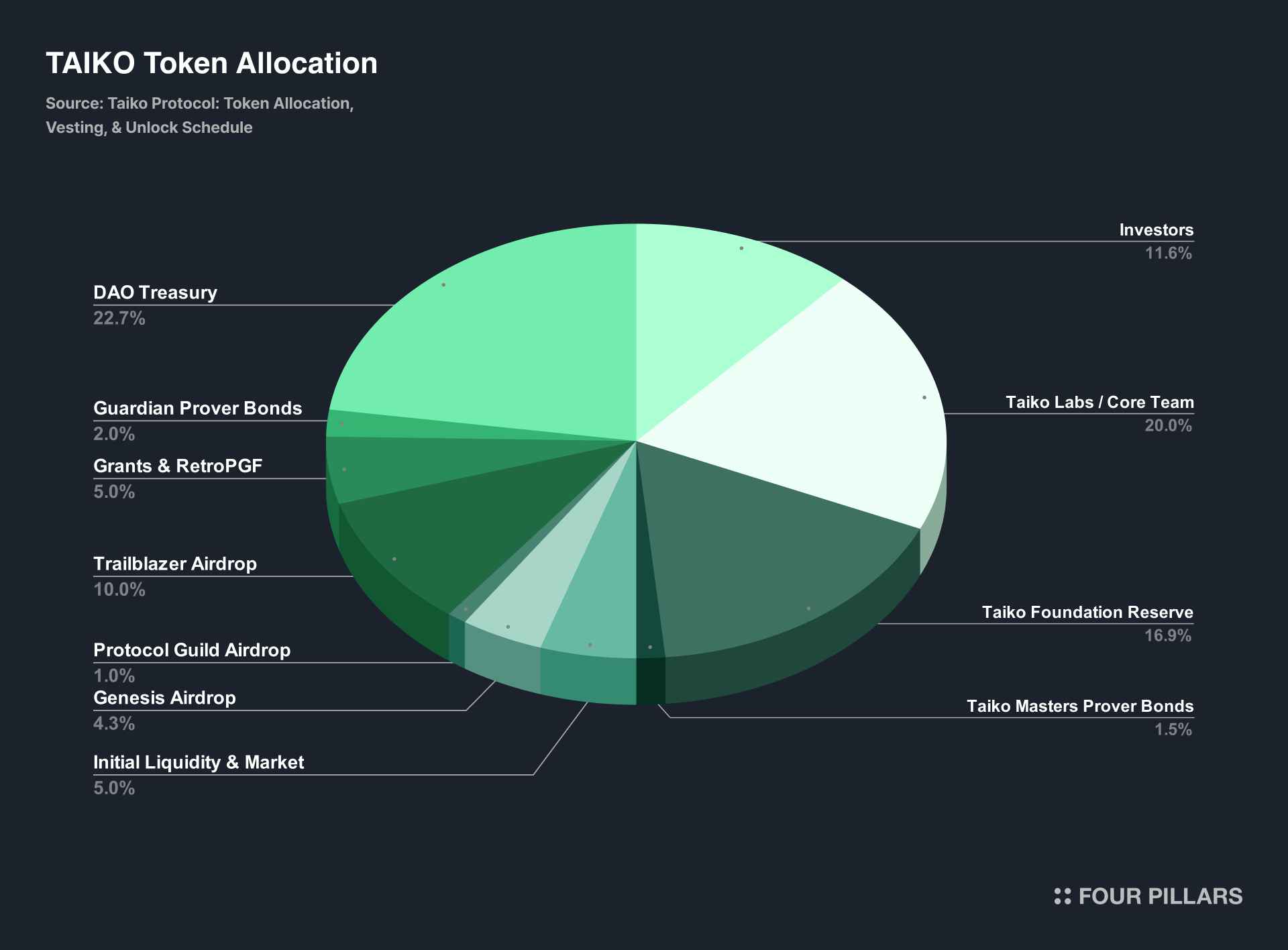
The distributed TAIKO tokens are subject to an initial 12-month lock-up period. After this period, 25% of the locked tokens will be released, with the remaining 75% being gradually unlocked over three years. This vesting structure is designed to minimize market volatility, encourage long-term participation in the Taiko ecosystem, and ultimately support the success of the Taiko project.
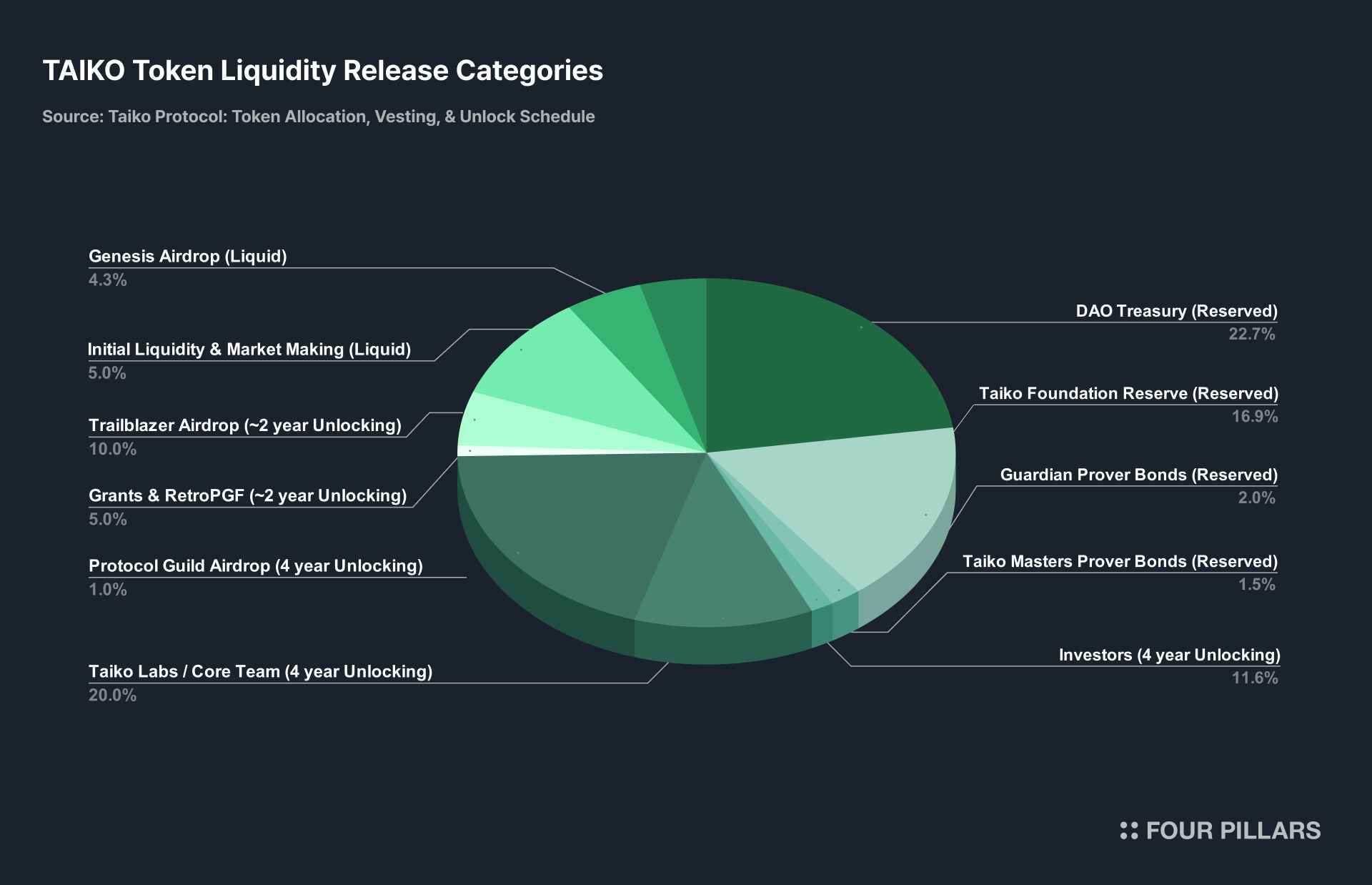
The token liquidity release schedule is illustrated in the graph below, with the green representing tokens already distributed, yellow representing tokens to be distributed over 2-4 years, orange representing tokens to be gradually distributed over three years starting one year after launch, and pink representing tokens allocated to protocol development, DAO governance, and network over five years or more.
3.2.2 Now - The Expanding Taiko Ecosystem

Source: Introducing Trailblazers: Explore Taiko and get rewarded
Taiko's Trailblazers program is a loyalty program where users can earn XP through various on-chain activities on the Taiko mainnet and receive rewards. 10% of the total TAIKO token supply has been allocated to this program, and users can earn more XP and level up by participating in activities. Certain NFT holders receive XP boosts, and the program offers a variety of activities and special events.
The program aims to encourage users to explore the Taiko ecosystem and actively engage with the community. XP can be earned by participating in activities such as bridging, increasing transaction volume, and proposing blocks on the Taiko mainnet. At the end of each season, rewards are distributed based on the accumulated XP.
Moreover, the Trailblazers program introduces a faction system, allowing users to form teams and compete within two factions (Based and Boosted). Users can collect badges associated with each faction, which provide bonuses such as additional XP. At the end of the season, the faction with the highest XP receives additional rewards. Developers can also participate in this program and receive rewards for the best-performing applications.
The purpose of the Trailblazers program is to attract more users to the Taiko ecosystem and enable them to gain experience and earn rewards through various activities.
Thanks to Taiko's active support, the Taiko ecosystem is rapidly growing. Further details on this will be covered in Chapter 4.
3.2.3 From Now On - Achieving Complete Decentralization through Taiko Governance
To achieve complete decentralization, Taiko allows the community to participate in decision-making through a DAO. Major decisions are made through votes by TAIKO token holders, determining the network's operational direction. However, Taiko's governance is still in its early stages and is not yet fully active. Therefore, the first committee will be established by Taiko Labs, and the addition and removal of committee members will be decided by a vote of the Taiko DAO.
Taiko is progressing steadily, if not quickly, toward the philosophy and ideas it aims to achieve. Taiko particularly emphasizes its goal of being a blockchain for users and builders, which is evident in the growing Taiko ecosystem following the mainnet launch. In the next chapter, we will delve into the development of the Taiko ecosystem.
Since the launch of the Taiko mainnet, significant progress has been made across various dimensions of the network. Over the past 90 days, Taiko has demonstrated substantial growth in network activity, profitability, user engagement, and technical advancements. In this section, let’s look into the metrics.
Taiko's mainnet has experienced growth in network activity, achieving over 100 million transactions. This surge in activity is further highlighted by the network handling up to 2,000,000 daily transactions, showcasing its robust capacity and growing adoption. The expanding user base is evidenced by the attraction of over 1,000,000 unique wallet addresses, reflecting strong user interest and engagement in Taiko's ecosystem.
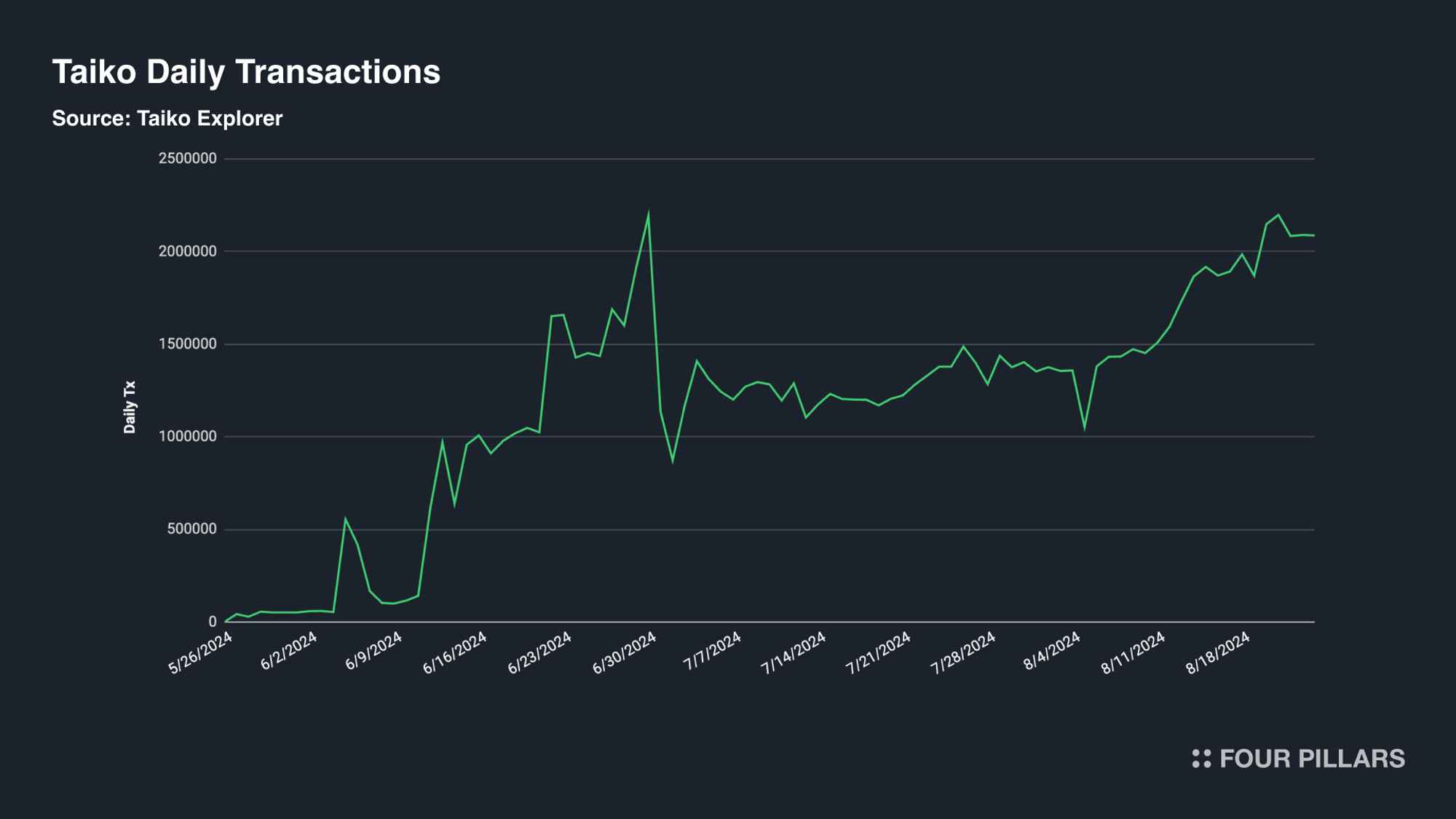
One of the noteworthy achievements post-mainnet launch is the profitability of Taiko Labs' proposer, which has become decentralized, permissionless, and becoming profitable. This milestone challenges the current understanding of Ethereum and opens new possibilities for Ethereum scaling solutions. Although Taiko has seen loses in the past, as more dapps are onboarded, it has been steadily moved to being profiable. It will be important to look into the upcoming months.
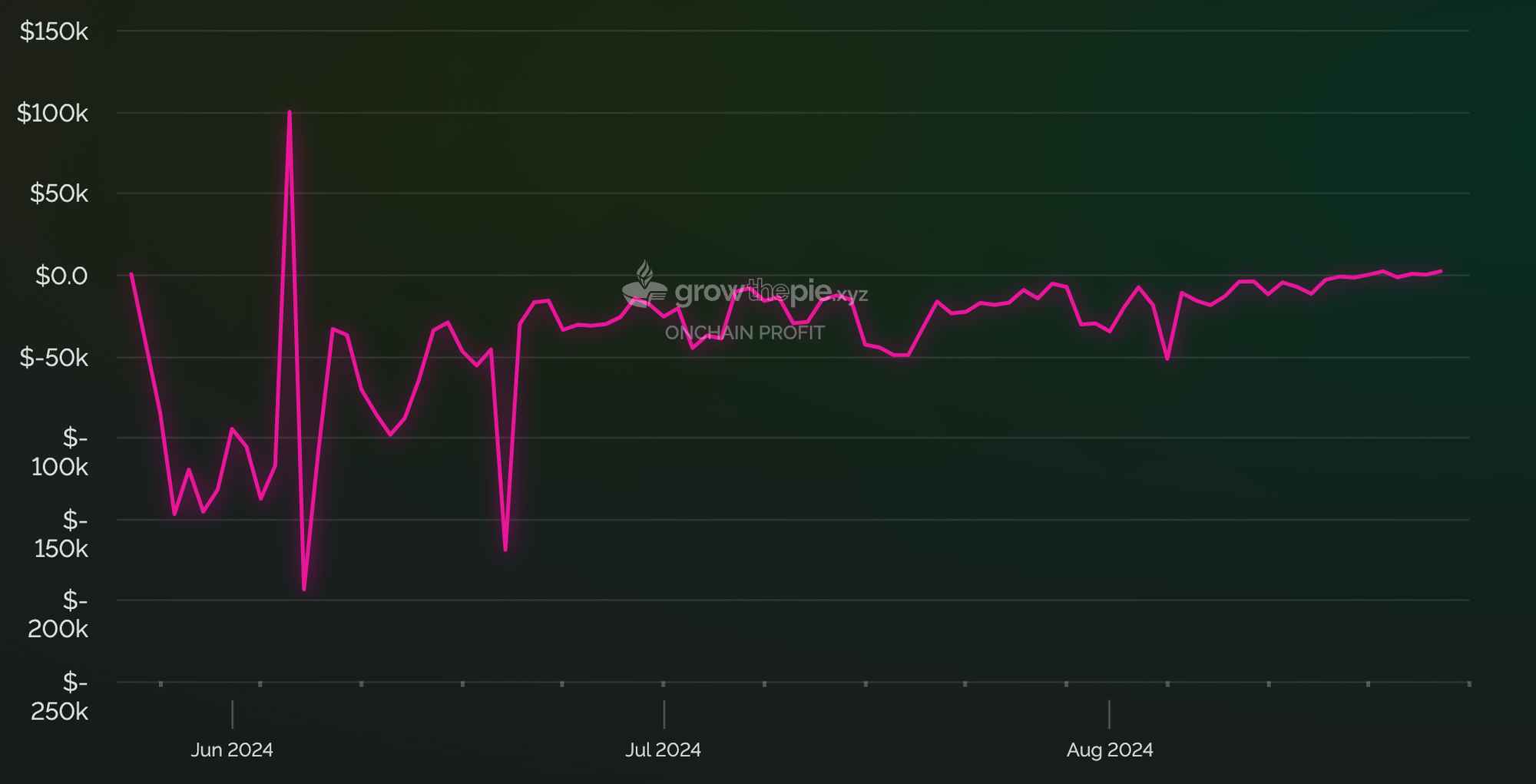
Source: Onchain Profit - growthepie
Taiko has made several technical advancements aimed at optimizing network performance and reducing costs. Notably, there has been a 30% reduction in the gas costs of the TaikoL1 contract, enhancing proposer profitability. Additionally, the reduction of the liveness bond and SGX proofs' validity and contestation bond by 50% has lowered capital costs, allowing more participants in Taiko's permissionless transaction sequencing.
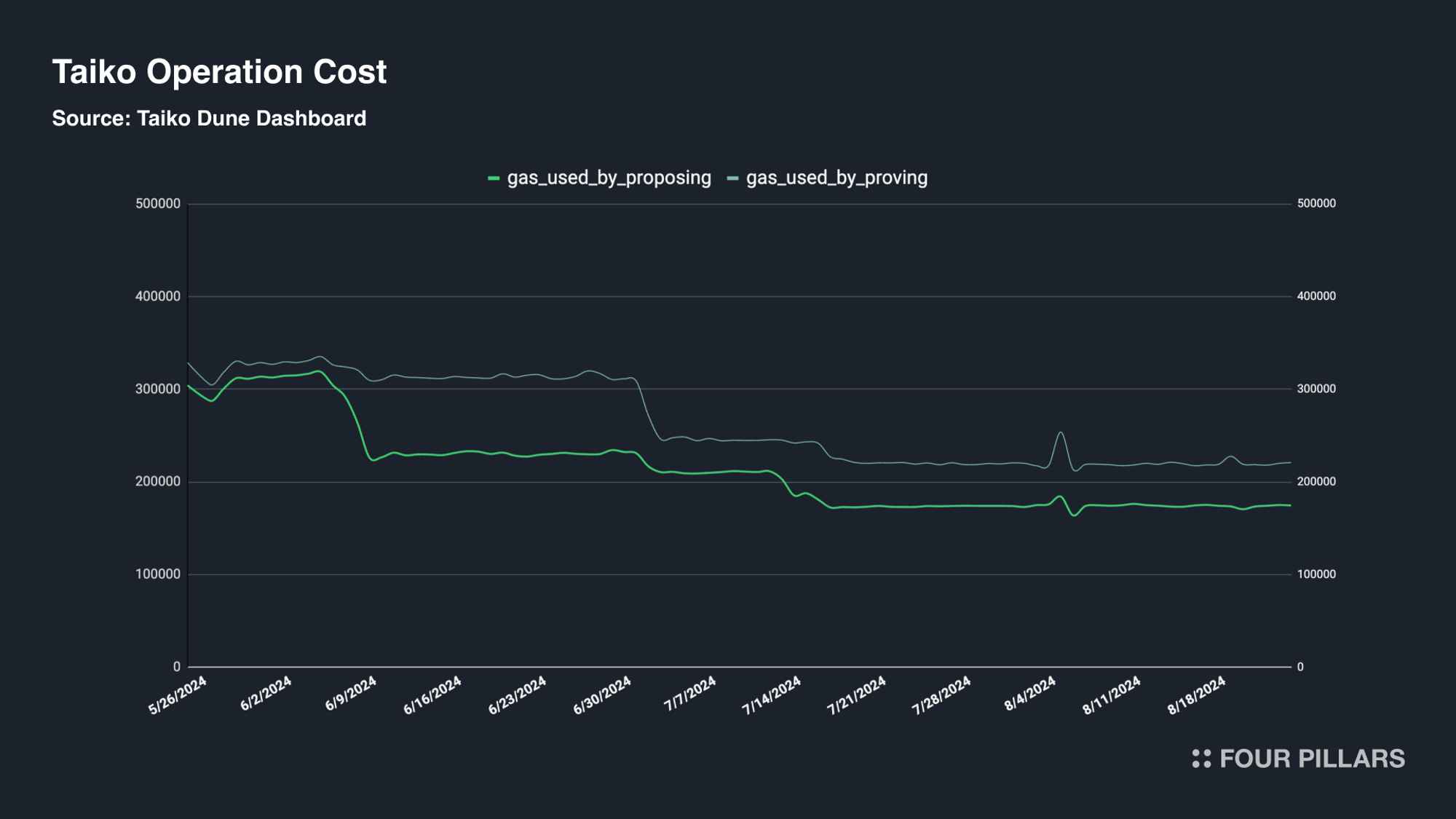

Source: Taiko Mirror
It has been nine years since Ethereum first appeared on the global stage. Over this period, Ethereum has experienced tremendous growth and has undergone numerous changes to address the growing pains that accompanied its expansion. Among these changes, the blueprint for Layer 2 solutions to tackle Ethereum’s scalability issues was a pivotal choice for Ethereum's next steps, leading to the current era of Ethereum L2 prominence. However, as time has passed, several Ethereum L2 solutions have emerged that diverge from the original Ethereum L2 narrative, resulting in relationships that are more competitive or antagonistic rather than cooperative with Ethereum, ultimately weakening Ethereum’s security.
Now, it is crucial to focus on identifying the “The True Ethereum L2” — those with the potential to become genuine partners rather than threats to Ethereum. This means we need to carefully discern which entities are genuinely focused on addressing the scalability challenges that Ethereum set out to solve and are taking the appropriate steps toward this goal. For this reason, Taiko has garnered significant attention. Taiko is progressing under the narrative of being a Ethereum-equivalent L2, a fully decentralized L2, and an L2 that prioritizes builders. Notably, Taiko is putting considerable effort into realizing these narratives, supported by strong technical foundations such as BCR and BBR.
Of course, many other Ethereum L2 projects are also striving in their own ways, so it remains uncertain which project will ultimately claim the throne in this era of Ethereum L2 dominance. However, it is no coincidence that Taiko's future trajectory is drawing widespread attention, as it is steadily turning its clear direction — to address Ethereum’s fundamental challenges — into tangible outcomes.
Dive into 'Narratives' that will be important in the next year